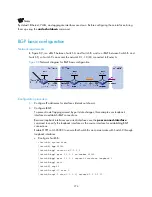
271
To do…
Use the command…
Remarks
Step 5
Configure the cluster ID
of the route reflector
reflector cluster-id
{
cluster-id
|
ip-address
}
Optional
By default, a route reflector uses
its router ID as the cluster ID.
•
Generally, it is not required to make clients of a route reflector fully meshed. The route reflector forwards
routing information between clients. If clients are fully meshed, you can disable route reflection between
clients to reduce routing costs.
•
Generally, a cluster has only one route reflector, and the router ID is used to identify the cluster. You can
configure multiple route reflectors to improve network stability. In this case, you must specify the same
cluster ID for these route reflectors to avoid routing loops.
Configuring a BGP confederation
To do…
Use the command…
Remarks
Step 1
Enter system view
system-view
—
Step 2
Enter BGP view
bgp
as-number
—
Step 3
Configure a
BGP
confederation
Configure a
confederation ID
confederation id
as-number
Required
Not configured by
default
Specify sub-ASs
contained in the
confederation
confederation peer-as
as-
number-list
Step 4
Enable compatibility with routers
not compliant with RFC 3065 in the
confederation
confederation nonstandard
Optional
Not enabled by
default
•
A confederation contains a maximum of 32 sub-ASs. The
as-number
of a sub-AS takes effect in the
confederation only.
•
If routers not compliant with RFC 3065 exist in the confederation, use the
confederation
nonstandard
command to make the local router compatible with these routers.
Configuring BGP GR
Perform the following configuration on the GR Restarter and GR Helper, respectively.






























